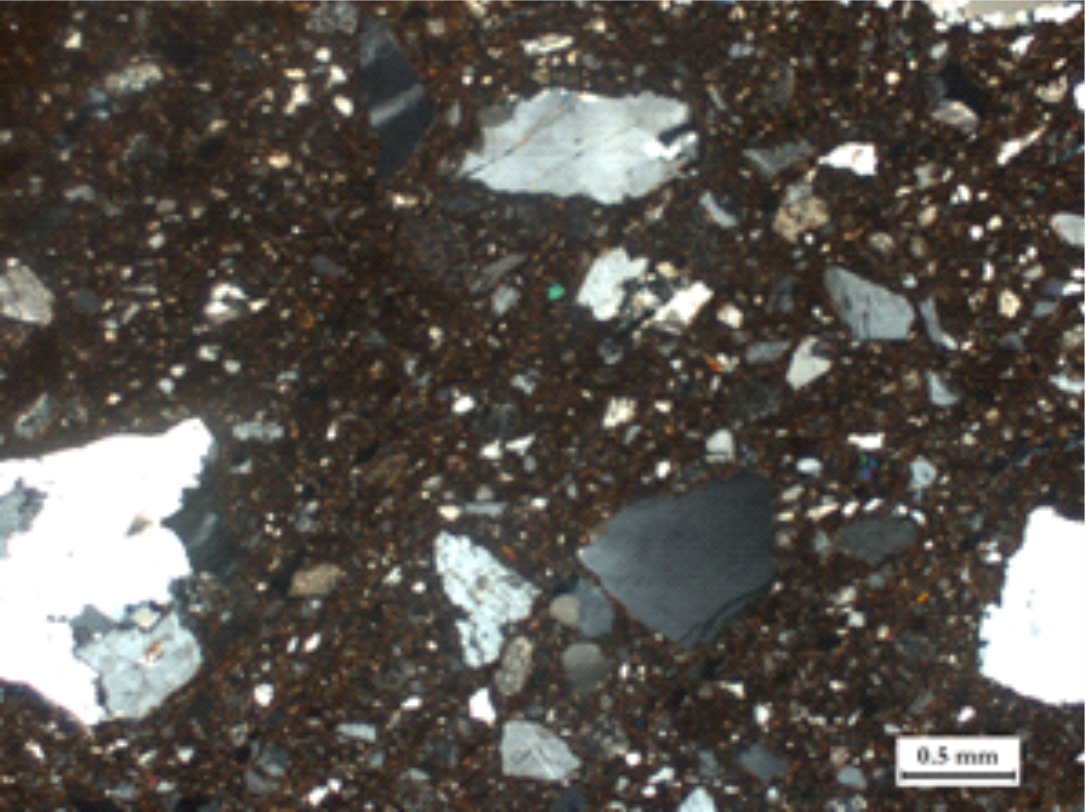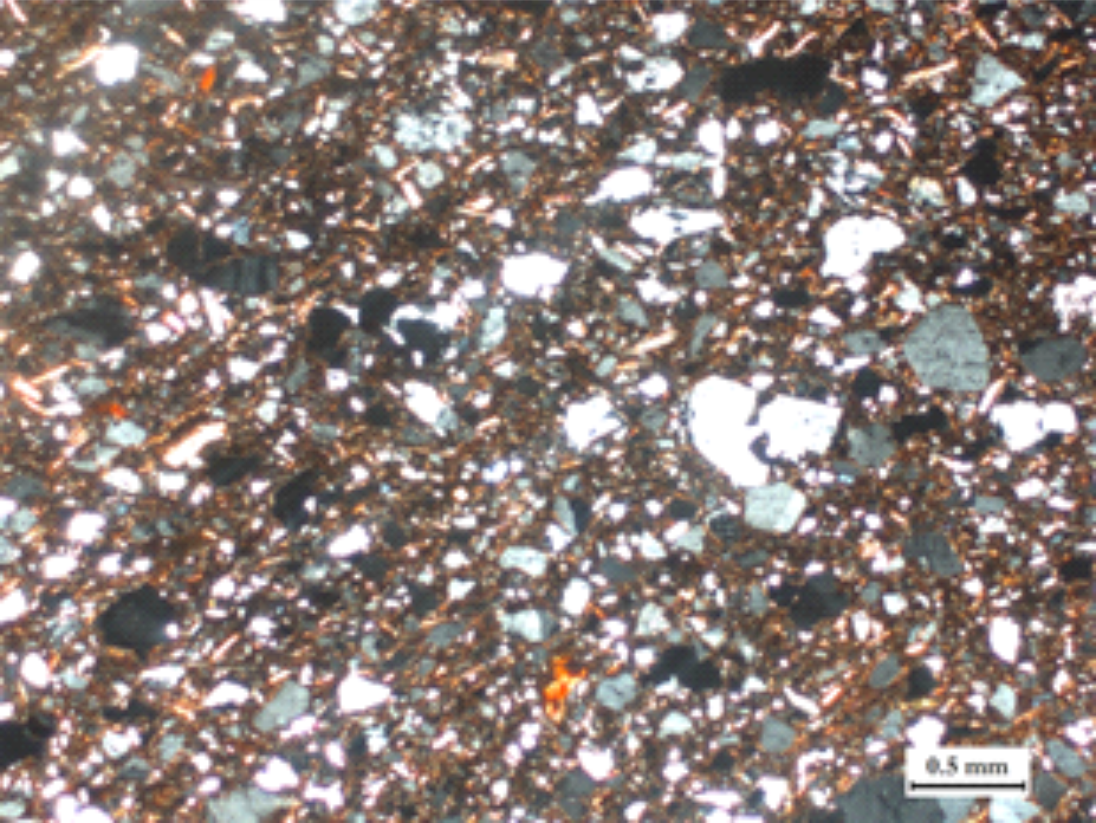Pottery petrographic analysis
Neolithic Settlement of Avgi, Kastoria, NW Greece:
Preliminary results of the pottery petrographic analysis
1.1 Sampling
The pottery assemblage under consideration derived from the west sector of the excavations at the settlement of Avgi, where residential remains representing (at least) three successive Late Neolithic building phases came to light. Sampling for the microscopic analysis was based both on macroscopic examination of the ceramic fabrics and various ceramic wares[1] present at the site. Additionally, all the shapes of open and closed vessels, such as bowls (Fig.1), jars, hole mouth jars and pithoids, were sampled, building a total of 43 samples.
1.2. Main objectives of the research
The main aim of our research is the compositional characterization of the fabrics used in pottery making, through ceramic petrography. The analysis provided further information on the raw materials used, while also highlighted issues related to technology. An attempt at detecting the sources of raw materials was made through the comparative examination of the results of the mineralogical study with published geological maps, allowing, hence, the discrimination of fabrics of local and possibly non-local origin (Rice 1987, Whitbread 1995). Our study also focused on the potentially different technological procedures employed in the making of ceramic wares, since the presence of technological variability can be linked to different use of vessels. In addition, technological variability could suggest multiple potting traditions at the site (Rice 1987, Rye 1981). Finally, the possible correlation between a specific fabric or fabrics with a distinct use-ware category was another objective of this research (Κiriatzi 2000, Kotsakis 1983, Tite and Kilikoglou 2002).
Fig. 1. Incised vessel: fabric microfotograph, microfotograph of thin-section, XP, field of view 1,44 mm.
2. Preliminary results of thin section analysis
Our preliminary petrographic analysis has, so far, identified six main fabric groups and four individual cases within the sample. More specifically, the predominant fabric groups are: a) AK.KY1: coarse fabric with quartzite and feldspars (Fig.2), b) AK.KY2: medium grained fabric with quartzite-feldspars, c) AK.KY3: Fine calcareous fabric (Fig.3), d) AK.KY4: Fine calcareous fabric with textural concentrations (Fig.4), e) AK.KY5: fine calcareous fabric with micrite calcite, and f) AK.KY10: coarse-grained fabric with phyllites and sedimentary rock fragments. The identified individual cases are: a) AK.KY6: fine calcareous fabric with chert, b) AK.KY7: medium-grained fabric with metamorphic rock fragments, c) AK.KY8: medium-grained fabric as a result of mixing a fine calcareous clay with a coarser medium grain size clay, and d) AK.KY9: coarse fabric with metamorphic rock fragments.
Based on the analysis we conclude that the Neolithic inhabitants of Avgi used coarse to medium-grained calcareous and non-calcareous clays. According to the geology of the region, the raw materials of the majority of our samples were of a local provenance. The presence of non-plastic inclusions (rocks and minerals) is also consistent with the broader geology of the area. Nonetheless, the ceramic fabric AK.KY10 probably does not fit with ceramic pastes of the local pottery production.
Apart from the provenance of raw materials, our study focused on other aspects of pottery making. Clay mixing was implemented as a technique for the preparation of the clay pastes in Avgi. The potters were combining fine calcareous clay with medium non-calcareous clay with quartz and feldspar inclusions, in order to prepare the suitable paste for their vessels. The frequent presence of clay pellets or textural concentrations could be linked to insufficient modelling of the clay. Potters at Avgi also refined the raw materials into medium and fine clays through sieving or levigation, which removed the coarser inclusions and resulted in a fabric with a certain and consistent size of inclusions. Even though ceramic fabrics AK.K1 and AK.K2 display similar non-plastic inclusions, the grain size of their constituent particles is different.
In conclusion, despite the preliminary stage of our research, we have already accomplished our basic aim, i.e. to define the predominant clay fabrics used by the Neolithic potters at Avgi. The available results also point towards a variability in the stages involved at the preparation of the clays pastes. Our future aim is to integrate these preliminary results into the macroscopic study of pottery and plan a geological prospection. Such a study will offer a complete picture of the local pottery production and could offer significant insight into the potential participation of the settlement to wider networks of pottery production.
Fig. 2. ΑΚ.ΚΥ1: Coarse fabric with quartz and feldspars, XP, fieldfield of view 4.5 mm.
Fig. 3. ΑΚ.ΚΥ2: Medium grained fabric with quartz and feldspars, XP, field of view 4.5 mm.
Fig. 4. ΑΚ.ΚΥ4: Fine calcareous clay with textural concentrations, XP, field of view 4.5 mm.
Bibliography
Kiriatzi, E. 2000. Keramiki Technologia kai Paragogi: I Keramiki tis Ysteris Epochis tou Chalkou apo tin Toumba Thessalonikis. Unpublished Ph.D. Thesis, Aristotle University of Thessaloniki.
Kotsakis, K. 1983. Kerameiki Technologia kai Kerameiki Diaforopoiisi: Provlimata tis Graptis Kerameikis tis Mesis Neolithikis Epochis tou Sesklou. Unpublished Ph.D. Dissertation, Aristotle University of Thessaloniki.
Rice, P.M., 1987. Pottery Analysis: a sourcebook. Chicago: The University Chicago Press.
Rye, O.S., 1981. Pottery technology: principles and reconstruction. Washington D.C.: Taraxacum.
Tite, M. and V., Kilikoglou 2002. Do we understand cooking pots and is there an ideal cooking pot? In V., Kilikoglou, A., Heins and Y., Maniatis (eds.), Modern trends in scientific studies on ancient ceramics: Papers presented at the 5th European meeting on ancient ceramics, Athens 1999. BAR International Series 1011. Oxford: Archaeopress, 1-8.
Whitbread, I.K., 1995. Greek transport amphorae: a petrological and archaeological study. The British School at Athens Fitch Laboratory Occasional Paper 4. Athens: British School in Athens.
Yannis Papadias & Niki Saridaki
PhD candidates of Prehistoric Archaeology,
Aristotle University of Thessaloniki
[1] The term ware is used to describe a group of vessels that share common features like surface treatment, decoration, fabric etc.





